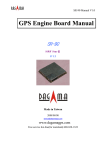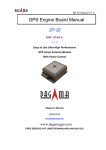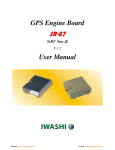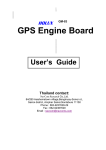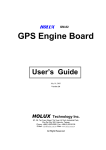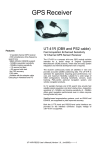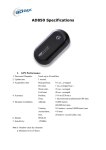Download C:\Documents and Settings\sfasdfasfa\My Documents\My QQ Files
Transcript
SR-89 Manual V1.0 GPS Engine Board Manual SR-89 SiRF Star Ⅲ V 1.1 Made in Taiwan 2008/08/08 [email protected] www.dagamagps.com Free service hot-line(for mainland):400-820-1322 SR-89 Manual V1.0 Specifications subject to change without prior notice! Contents 1. Introduction 1.1 Overview ………………………………………………………..…………. 3 ……………………………………………………………………. 3 2. Technical Specifications …………………………………………………… 4 2.1. Electrical Characteristics…………………………………………………. 4 2.2. Environmental Characteristics……………………………………..……… 5 2.3. Physical Characteristics……………………………………………...…..… 5 3. Applications ……………………………………………………………… 6 4. Operation and Test (optional) ………………..……………… 7 Appendix: Software Specifications ……………………………………….. 8 SR-89 User’s Manual V1.1 2 SR-89 Manual V1.0 1. Introduction 1.1. Overview Product Introduction The SR-89 GPS modules incorporates high sensitivity, high performance SiRF StarⅢ chipset solution in a compact design. The module tracks up to 20 satellites at a time while offering fast time-to-first-fix and 1Hz navigation update. The unit is very suitable for space-sensitive applications. Main Features ■ High sensitivity SiRF StarⅢ chipset. ■ High performance receiver tracks up to 20 satellites. ■ TTL output for GPS command interface. ■ Low power consumption. ■ Average Cold Start time under 42 seconds. ■ On-chip 1Mb SRAM. ■ Reacquisition time 0.1 second. ■ Support accurate 1PPS output signal aligned with GPS timing. ■ Support Standard NMEA-0183 and SiRF Binary protocol. ■ WAAS/EGNOS support ■ Compact size 28.2mm*20mm*2.9mm ■ Easy integration into hand-held devices. The SR-89 design utilizes the latest surface mount technology and high level circuit integration to achieve superior performance while minimizing dimension and power consumption. This hardware capability combined with software intelligence makes the board easy to be integrated and used in all kinds of navigation applications or products. The module communicates with application system via TTL level with NMEA-0183 protocol. SR-89 User’s Manual V1.1 3 SR-89 Manual V1.0 2. Technical Specifications 2.1. Electrical Characteristics 2.1.1 General Frequency L1, 1575.42 MHz C/A code 1.023 MHz chip rate Channels 20 channels all in view tracking 2.1.2 Sensitivity Tracking -159 dBm typical 2.1.3 Accuracy (Open Sky) Position Time 2.1.4 Datum Default < 10 meters, 2D RMS < 7 meters 2D RMS, WAAS corrected 1-5 meters, DGPS corrected 1 microsecond synchronized to GPS time WGS-84 2.1.5 Acquisition Rate (Open Sky) Hot start 1 sec, average Warm start 38 sec, average Cold start 42 sec, average Reacquisition 0.1 sec, average 2.1.6 Dynamic Conditions Altitude Velocity Acceleration Jerk < 18,000 meters (60,000 feet) < 515 meters/sec (1000 knots) <4G 20 meters/sec max 2.1.7 Power Main power input Supply Current 3.3 VDC, ±5% < 80 mA SR-89 User’s Manual V1.1 4 SR-89 Manual V1.0 2.1.8 Serial Port Electrical interface Protocol support Default NMEA TTL level NMEA-0183, SiRF Binary GGA, GSA, GSV, RMC, (GLL, VTG, and ZDA optional) 4800 baud rate (other rate optional) 8 bits data, 1 stop bit, no parity. 2.1.9 Time 1 PPS Pulse, pulse duration 1µs. Time reference at the pulse positive edge. Synchronized to GPS time, ±1µs. 2.2. Environmental Characteristics Operating temperature range Storage temperature range -40 oC to +85 oC -45 oC to +100 oC 2.3. Physical Characteristics Mechanical Outline SR-89 User’s Manual V1.1 5 SR-89 Manual V1.0 Pin assignment Pin Pin Name 1 GND Function description Pin Pin Name 8 BATTERY Ground Function description Backup battery input (2.5–3.3V) 2 RFIN GPS RF signal input 9 LED_ON_OFF 3 GND Ground 10 TX Serial Data Output 4 GND Ground 11 RX Serial Data input 5 GND Ground 12 GND Ground 6 GND Ground 13 GND Ground 7 VCC_IN 1 Hz High/Low pulse output +3V DC power input 3. Applications The SR-89 engine module is a high performance, ultra low power consumption, GPS receiver. Applications are as follow: Car Navigation Wrist Watch Solar Operated Device Marine Navigation Fleet Management AVL and Location-Based Services Radar detector with GPS function Hand-Held Device for Personal Positioning and Navigation Ideal for PDA, Pocket PC and Other Computing Devices at GPS Application SR-89 User’s Manual V1.1 6 SR-89 Manual V1.0 4. Operation and Test (optional) The customers can change the data protocol and communication data baud rate for their applications using a GPS Viewer software. Installing appropriate viewer program to host device, you may check the status of the GPS receiver whenever you like to. Following are standard buttons and operation steps. (a) Execute the Viewer program. Press the “COM” button to set “Com Port” for this data link and “Baud Rate” to 4800. (b) Click “OPEN” to download the received data. Usually one window shows the NMEA format data stream and another window shows tracked satellite constellation and signal quality status. (c) Once the link is successful, click “CLOSE” button to exit the program. However, you may click the “Cold” button to perform “cold start” testing. SR-89 User’s Manual V1.1 7 SR-89 Manual V1.0 Appendix: Software Specifications NMEA Protocol The SR-89 software is capable of supporting the following NMEA message formats specifically developed and defined by SiRF. NMEA Message Prefix Format Direction $GPGGA Time, position and fix type data. Out $GPGLL Latitude, longitude, time of position fix and status. Out $GPGSA GNSS DOP and active satellites Out $GPGSV Satellites in view. Out $GPMSS Radio beacon signal-to-noise ratio, signal strength, frequency, etc. Out $GPRMC Recommended minimum specific GNSS data. Out $GPVTG Speed and course over ground. Out $GPZDA Date and time. Out General NMEA Format The general NMEA format consists of an ASCII string commencing with a ‘$’ character and terminating with a <CR><LF> sequence. NMEA standard messages commence with ‘GP’ then a 3-letter message identifier. The message header is followed by a comma delimited list of fields optionally terminated with a checksum consisting of an asterix ‘*’ and a 2 digit hex value representing the checksum. There is no comma preceding the checksum field. When present, the checksum is calculated as a bitwise exclusive of the characters between the ‘$’ and ‘*’. As an ASCII representation, the number of digits in each number will vary depending on the number and precision, hence the record length will vary. Certain fields may be omitted if they are not used, in which case the field position is reserved using commas to ensure correct interpretation of subsequent fields. SR-89 User’s Manual V1.1 8 SR-89 Manual V1.0 $GPGGA This message transfers global positioning system fix data. Following is an example. $GPGGA,161229.487,3723.2475,N,12158.3416,W,1,07,1.0,9.0,M, , , ,0000*18 The $GPGGA message structure is shown below: Field Example Message ID $GPGGA GGA protocol header. UTC Time 161229.487 hhmmss.sss Latitude 3723.2475 ddmm.mmmm N/S Indicator N N=north or S=south. Longitude 12158.3416 dddmm.mmmm E/W indicator W E=east or W=west. Position Fix Indictor 1 0: Fix not available or invalid. 1: GPS SPS mode, fix valid. 2: Differ. GPS, SPS mode, fix valid 3-5: Not supported. 6: Dead Reckoning Mode, fix valid. (1) Satellites Used 07 Number of satellites used to calculate fix. Range 0 to 12. HDOP 1.0 Horizontal Dilution of Precision. MSL Altitude (2) Unit Notes 9.0 Meter Altitude above mean seal level. M Meter M stands for “meters”. Geoid Separation (2) Meter Separation from Geoids can be blank. Units Meter M stands for “meters”. Age of Diff. Corr. Second Age in seconds. Blank (Null) fields when DGPS is not used. Units Diff Ref. Station ID 0000 Checksum *18 <CR> <LF> Message terminator. (1) Only apply to NMEA version 2.3 (and later) in this NMEA message description. (2) SiRF does not support geoid corrections. Values are WGS84 ellipsoid heights. SR-89 User’s Manual V1.1 9 SR-89 Manual V1.0 $GPGLL This message transfers geographic position, latitude, longitude, and time. Following is an example. $GPGLL,3723.2475,N,12158.3416,W,161229.487,A,A*41 The $GPGLL message structure is shown below: Field Example Unit Message ID $GPGLL GLL protocol header. Latitude 3723.2475 ddmm.mmmm N/S Indicator N N=north or S=south. Longitude 12158.3416 dddmm.mmmm E/W indicator W E=east or W=west. UTC Time 161229.487 hhmmss.sss Status A A: Data valid or V: Data invalid. Mode A A=Autonomous, D=DGPS, E=DR (Only present in NMEA version 3.00). Checksum *41 <CR><LF> Notes Message terminator. SR-89 User’s Manual V1.1 10 SR-89 Manual V1.0 $GPGSA This message transfers DOP and active satellites information. Following is an example. $GPGSA,A,3,07,02,26,27,09,04,15, , , , , ,1.8,1.0,1.5*33 The $GPGSA message structure is shown below: Field Example Unit Notes Message ID $GPGSA GSA protocol header. Mode A M: Manual, forced to operate in selected 2D or 3D mode. A: Automatic switching between modes. Mode 3 1 2 3 Satellites Used (1) 07 SV on channel 1. Satellites Used (1) 02 SV on channel 2. Fix not available. 2D position fix. 3D position fix. … .. Satellites Used (1) SV on channel 12. PDOP 1.8 HDOP 1.0 VDOP 1.5 Checksum *33 <CR> <LF> Message terminator. (1) Satellites used in solution. SR-89 User’s Manual V1.1 11 SR-89 Manual V1.0 $GPGSV This message transfers information about satellites in view. The $GPGSV message structure is shown below. Each record contains the information for up to 4 channels, allowing up to 12 satellites in view. In the final record of the sequence the unused channel fields are left blank with commas to indicate that a field has been omitted. Following is an example. $GPGSV,2,1,07,07,79,048,42,02,51,062,43,26,36,256,42,27,27,138,42*71 $GPGSV,2,2,07,09,23,313,42,04,19,159,41,15,12,041,42*41 The $GPGSV message structure is shown below: Field Example Message ID Unit Notes $GPGSV GSA protocol header. 2 Number of messages, maximum 3. Message number 1 Sequence number, range 1 to 3. Satellites in view 07 Number of satellites currently in view. Satellite ID 07 Channel 1, ID range 1 to 32. Elevation 79 degree Elevation of satellite, maximum 90. Azimuth 048 degree Azimuth of satellite, range 0 to 359. SNR (C/N0) 42 dBHz Range 0 to 99, null when not tracking. Satellite ID 02 Elevation 51 degree Elevation of satellite, maximum 90. Azimuth 062 degree Azimuth of satellite, range 0 to 359. SNR (C/N0) 43 dBHz Range 0 to 99, null when not tracking. Satellite ID 26 Elevation 36 degree Elevation of satellite, maximum 90. Azimuth 256 degree Azimuth of satellite, range 0 to 359. SNR (C/N0) 42 dBHz Range 0 to 99, null when not tracking. Satellite ID 27 Elevation 27 degree Elevation of satellite, maximum 90. Azimuth 138 degree Azimuth of satellite, range 0 to 359. SNR (C/N0) 42 dBHz Range 0 to 99, null when not tracking. Checksum *71 Number of messages (1) Channel 2, ID range 1 to 32. Channel 3, ID range 1 to 32. Channel 4, ID range 1 to 32. <CR> <LF> Message terminator. (1) Depending on the number of satellites tracked multiple messages of GSV data may be required. SR-89 User’s Manual V1.1 12 SR-89 Manual V1.0 $GPMSS This message transfers information about radio beacon signal-to-noise ratio, signal strength, frequency, etc. Following is an example. $GPMSS,55,27,318.0,100,1,*57 The $GPMSS message format is shown below. Field Example Unit Notes Message ID $GPMSS Signal Strength 55 dB SS of tracked frequency. Signal-to-Noise Ratio 27 dB SNR of tracked frequency. Beacon Frequency 318.0 kHz Currently tracked frequency. Beacon Bit Rate 100 Bits per second. Channel Number (1) 1 The channel of the beacon being used if a multi-channel beacon receiver is used. Checksum *57 MSS protocol header. <CR> <LF> Message terminator. (1) Fields marked in italic red apply only to NMEA version 2.3 (and later) in this NMEA message description. SR-89 User’s Manual V1.1 13 SR-89 Manual V1.0 $GPRMC This message transfers recommended minimum specific GNSS data. Following is an example. $GPRMC,161229.487,A,3723.2475,N,12158.3416,W,0.13,309.62,120598, ,*10 The $GPRMC message format is shown below. Field Example Message ID $GPRMC RMC protocol header. UTC Time 161229.487 hhmmss.sss Status A A: Data valid or V: Data invalid. Latitude 3723.2475 ddmm.mmmm N/S Indicator N N=north or S=south. Longitude 12158.3416 ddmm.mmmm E/W indicator W E=east or W=west. Speed over ground 0.13 knot Speed over ground Course over ground 309.62 degree Course over ground Date 120598 Magnetic variation (1) Unit ddmmyy, current date. degree Mode (2) A Checksum *10 Not used. A=Autonomous, D=DGPS, E=DR. <CR> <LF> (1) SiRF does not support magnetic declination. Notes Message terminator. All “course over ground” data are geodetic WGS84 directions. (2) Fields marked in italic red apply only to NMEA version 2.3 (and later) in this NMEA message description. SR-89 User’s Manual V1.1 14 SR-89 Manual V1.0 $GPVTG This message transfers velocity, course over ground, and ground speed. Following is an example. $GPVTG,309.62,T, ,M,0.13,N,0.2,K,A*23 The $GPVTG message format is shown below. Field Example Message ID $GPVTG Course (true) 309.62 Reference T Course (magnetic) Unit Notes VTG protocol header. degree Measured heading T = true heading degree Measured heading Reference (1) M M = magnetic heading (1) Speed 0.13 Units N Speed 0.2 Units K K = km/hour. Mode (2) A A=Autonomous, D=DGPS, E=DR. Checksum *23 knot N = knots km/hr <CR> <LF> (1) SiRF does not support magnetic declination. Speed in knots Speed Message terminator. All “course over ground” data are geodetic WGS84 directions. (2) Fields marked in italic red apply only to NMEA version 2.3 (and later) in this NMEA message description. SR-89 User’s Manual V1.1 15 SR-89 Manual V1.0 $GPZDA This message transfers UTC Time and Date. Following is an example. $GPZDA,181813,14,10,2003,00,00*4F The $GPZDA message format is shown below. Field Example Unit Message ID $GPZDA ZDA protocol header. UTC Time 181813 Either using valid IONO/UTC or estimated from default leap seconds. UTC Day 14 01 to 31, day of month. UTC Month 10 01 to 12. UTC Year 2003 1980 to 2079. Local zone hours 00 Offset from UTC (set to 00). Local zone minutes 00 Offset from UTC (set to 00). Checksum *4F <CR> <LF> Notes Message terminator. All Rights Reserved SR-89 User’s Manual V1.1 16
















